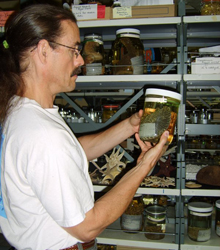Interview with a Smithsonian Scietist: Museum Specialist, Tim Coffer
Tim Coffer is a museum specialist in the Department of Invertebrate Zoology at the Smithsonian National Museum of Natural History. Coffer has a B.S. in Marine Biology from the Florida Institute of Technology.

Q. How did you first come to love science?
A. As a kid, I was always the guy digging around in the backyard for bugs and spiders. Sometimes, it got out of hand! Once, a clutch of praying mantis eggs hatched in my bathroom. Tiny baby praying mantises spread out everywhere - they looked just like grains of sand all over the walls. Another time, a butterfly I was observing laid its eggs in my father's minnow bucket before he went fishing.
Q. Did you study science in school?
A. Yes, but back then science classes were different from what they are today. There were not many options for students passionate about science who wanted to take advanced classes. In my high school, science was a very set curriculum, without the option to study at a local college, for instance.
Now, some of the high school interns who work with me at the NMNH also study at the University of Maryland and other colleges in the area. It's great that curious students today have more opportunities to develop.
Q. What is your job at the museum and are your qualifications as a scientist?
A. Officially, I am a Museum Specialist for the NMNH's Department of Invertebrate Zoology. In practice, this means that I do research support for Cnidaria, provide logistics support and serve as the Deputy Collections Manager for Invertebrate Zoology.
I received a B.S. in Marine Biology and decided to take some time off and find a job while I considered graduate school. For the next 2 years, I was a lab assistant at George Mason University (GMU), working in the Psychology Department. I tended their animal colony, performed crude post-testing histology and helped set up test equipment.
Q. How did you get involved with the Smithsonian?
A. While working at GMU, I became aware of temporary employment opportunities at the NMNH in the National Collections Inventory Program. I took a temporary position at the NMNH that was extended over the course of the next 18 months. I then hopped aboard a newly forming crew of museum technicians funded by the Bureau of Land Management (BLM) to receive, curate and catalog marine invertebrate specimens collected to assess the biota within BLM's offshore oil lease areas.
This further exposed me to museum collections; how they are maintained, organized, accessed for research as well as how their growth is both encouraged and kept in check. It also opened up the science of Taxonomy to me, something that is only brushed on in undergraduate biology studies. I spent many late evenings at the museum identifying specimens, reading the necessary literature and getting spooked when noises made me wonder if the museum really is haunted by the spirits of curators from days gone by! :)
Q. How do you feel about your role as a scientist at this point in your career?
A. I serve as a mentor to young museum support staff, who together are the backbone that keeps our collections accessible to all. People in these roles need to have a basic knowledge of museums in general, as well as marine biology (since the Department of Invertebrate Zoology is 90% marine-oriented). It's even better if they have an interest, or even proficiency, in one of the groups of animals under our realm of responsibility.
Although I do a lot of work with our younger staff now, the basics of marine biology (like being able to look at and identity a new specimen) will always be fun.
Q. How do you think students and classes can get the most out of visiting the museums?
A. Beyond a visit to explore the public displays, it's always possible to request a behind-the-scenes tour from one of our scientists in advance. We have extensive collections and can't put them all on display at one time, so it's worth asking to see more if you have a special area of interest.
Internships are another great way to get involved on a deeper level. We routinely have sophomore, junior and senior high school students take part in internships and are currently hosting some Langley High School students doing a leap program to move into college undergraduate courses.
Interns can make a big difference to the museum. As we move our coral collections down to a new storage facility, I'm preparing to welcome a new George Washington University intern with an interest in exhibition design and collections management to look at how we can better display our specimens, even within the archives.
Q. How can teachers tap into the volunteers at the museum?
A. As an educational facility and an archive, we certainly want to attract educated audiences, but this will only give us validation, not a new direction for our future. We need to raise the next generation of scientists by tantalizing them, planting the seeds of curiosity and enquiry and hoping those roots grow into a love of science!
That's why it's important for people, especially students and teachers, to know that the museum is a dynamic place. There's a lot more to it than everyone sees. Look around on our website for links to help you get involved. You have to be diligent with your search pattern, but be forward and ask for help in finding an option that works for you.
We look forward to welcoming you! Please visit our blog to keep up with the latest: https://nmnh.typepad.com/no_bones/